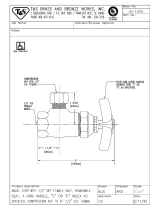
TABLE OF CONTENTS
© Midmark Corporation 2000 SF-1605 Page 4 Printed in U.S.A.
Typical Concept LR Unit ............................ 5-20
Wiring Diagrams
Typical Delivery Head................................. 5-21
Typical Console ......................................... 5-22
APC Power Supply .................................... 5-23
Typical Concept LR Unit ............................. 5-24
Accessories
Typical Handpiece Illumination Setup......... 5-25
Typical Scaler System Setup...................... 5-26
SECTION VI PARTS LIST
6.1 Introduction ................................................. 6-1
6.2 Description Of Columns ............................... 6-1
6.3 Torque Specifications And Important
Assembly Notes ........................................ 6-1
Pictorial Index
Asepsis 21 Console Unit .............................. 6-2
Whip-style Console Unit ............................... 6-3
Asepsis 21 Concept LR Unit ........................ 6-4
Whip-style Concept LR Unit ......................... 6-5
Asepsis 21 SLC Unit ................................... 6-6
Whip-style SLC Unit .................................... 6-7
Cart Assemblies ........................................... 6-8
Asepsis 21 Duo & Assistant’s Wall/Cabinet
Mounted Systems ..................................... 6-9
Long/Short Arm Side Delivery Systems ..... 6-10
Rear Delivery Systems............................... 6-11
Tubing & Connectors
Asepsis 21 Handpiece Tubing .................... 6-12
Whip Unit Handpiece Tubing .....................6-13*
Asepsis 21 Syringe Tubing ......................... 6-14
Whip Unit Syringe Tubing..........................6-15*
Internal Tubing............................................ 6-16
Connectors & Fittings ................................. 6-17
Delivery Head
Asepsis 21 Delivery Unit Overview ............ 6-18
Whip-style Delivery Unit Overview ............. 6-19
Asepsis 21 Delivery Unit
Cover Components ................................6-20*
Whip Unit Cover Components ...................6-21*
Asepsis 21 Delivery Unit
Pneumatic / Hydraulic Components.......6-22*
Whip Unit Pneumatic/Hydraulic
Components............................................ 6-23
Kink Valve................................................... 6-24
Whip Assembly..........................................6-25*
Whip Unit Instrument Tray Assembly.......... 6-26
Cuspidor
Cuspidor Assembly Overview..................... 6-27
Cuspidor Assy Enclosure Components.....6-28*
Cuspidor Assy with Components ............... 6-29
. Console
Chair Mounted Console Assy Overview .... 6-30
Floor Mounted Console Assy Overview..... 6-31
Chair Mounted Console Assembly
Enclosure Components .......................... 6-32
Chair Mounted Console Assy.
Internal Components .............................6-33*
Floor Mounted Console Assy
Housing Components ............................. 6-34
Floor Mounted Console Assy
Base Components .................................. 6-35
FM Console Power Cord/
Receptacle Assembly ............................. 6-36
Cart & Side/Rear Delivery Systems
Instrument Tray Arm Assembly .................. 6-37
Tub Support Arm Assembly ....................... 6-38
Asepsis 21 Duo / Assistant’s
Top Components.................................... 6-39*
Asepsis 21 Duo / Assistant’s
Housing Components ............................. 6-40*
Mobile Work Surface Top Components..... 6-41*
Cart Assembly Base Components ............. 6-42
Duo Arm Assembly (Adjustable) ............... 6-43*
Duo Arm Pivot Joint Assembly................... 6-44
Duo Unit Wall Mount Components............. 6-45
Duo Unit Cabinet Mount Components ....... 6-46
Side Delivery Unit Wall Mount
Components ........................................... 6-47
Side Delivery Unit Cabinet Mount
Components ........................................... 6-48
Rear Delivery Unit Cabinet Mount
Components ........................................... 6-49
Delivery Arms
Air Lock Flex Arm Assembly ..................... 6-50*
Manual Lock Flex Arm Assembly............... 6-51
Delivery Unit Arm Assembly ..................... 6-52*
SLC Unit Mounting Components ............... 6-53
Fixed Arm Assembly .................................. 6-54
LR Units
LR Unit Arm Assembly.............................. 6-55*
LR Console Components........................... 6-56
LR Vac Pak Upper Components ............... 6-57*
LR Vac Pak Lower Components ............... 6-58*
LR Cuspidor Assembly............................... 6-59
LR Assistant’s Instrument Holder.............. 6-60*
LR Unit Instrument Tray Assembly............. 6-61
Rev. 3/06
























